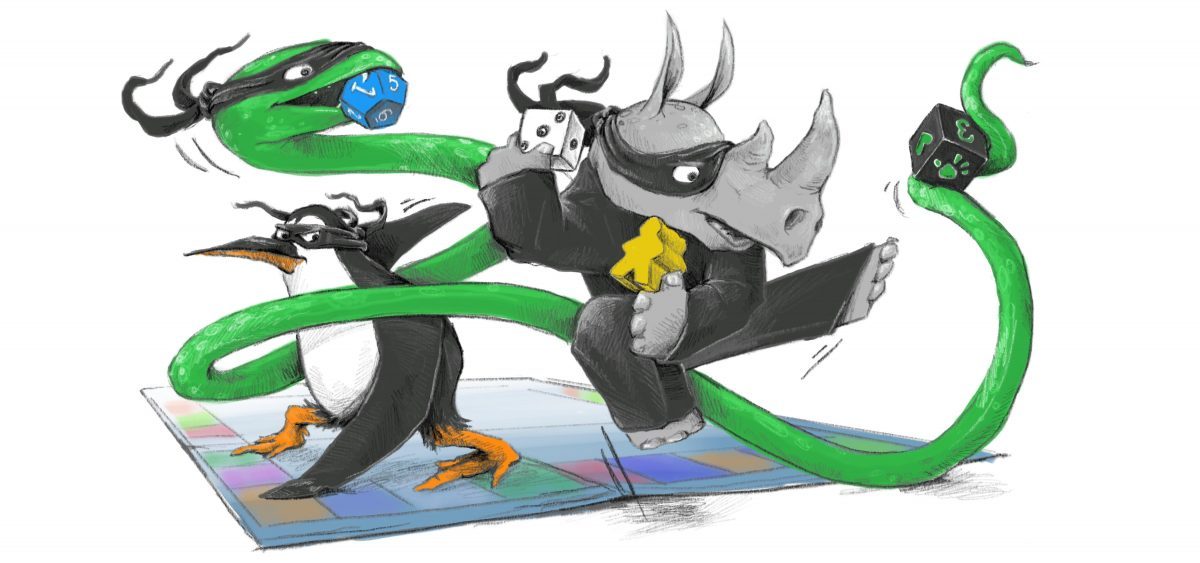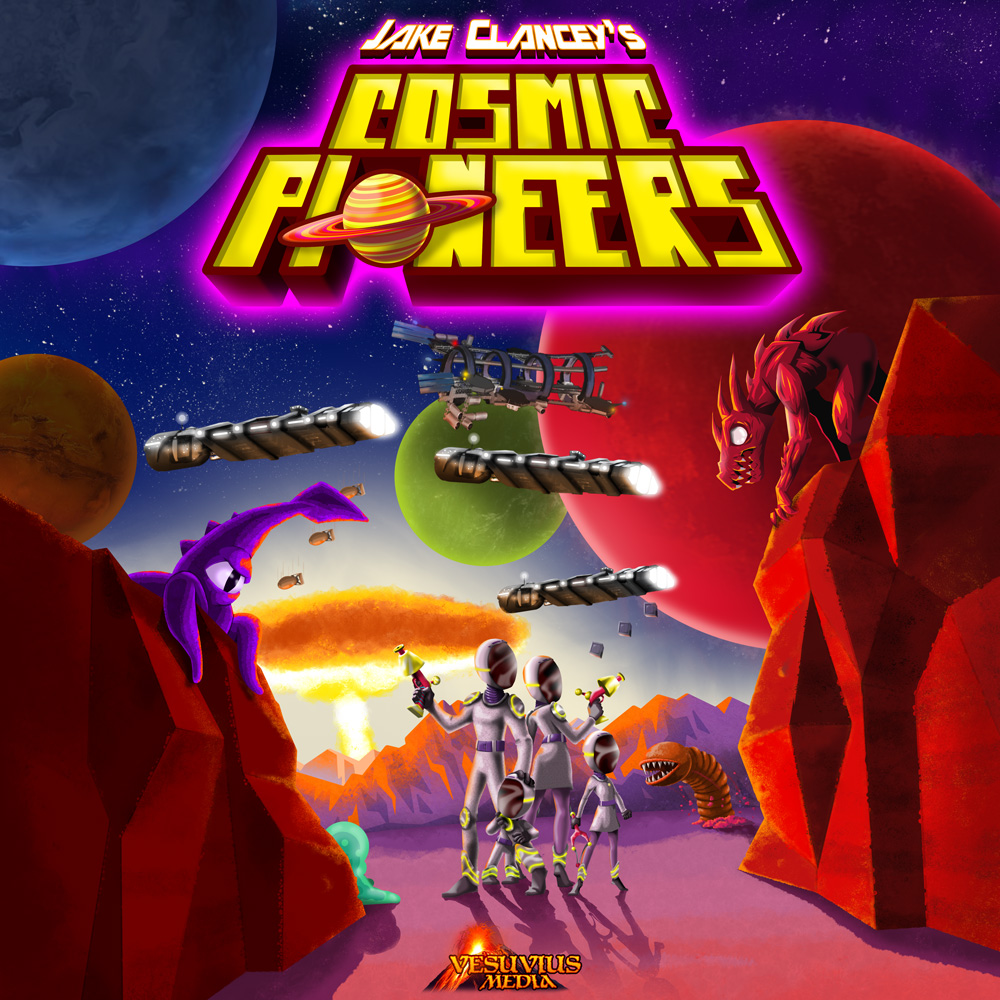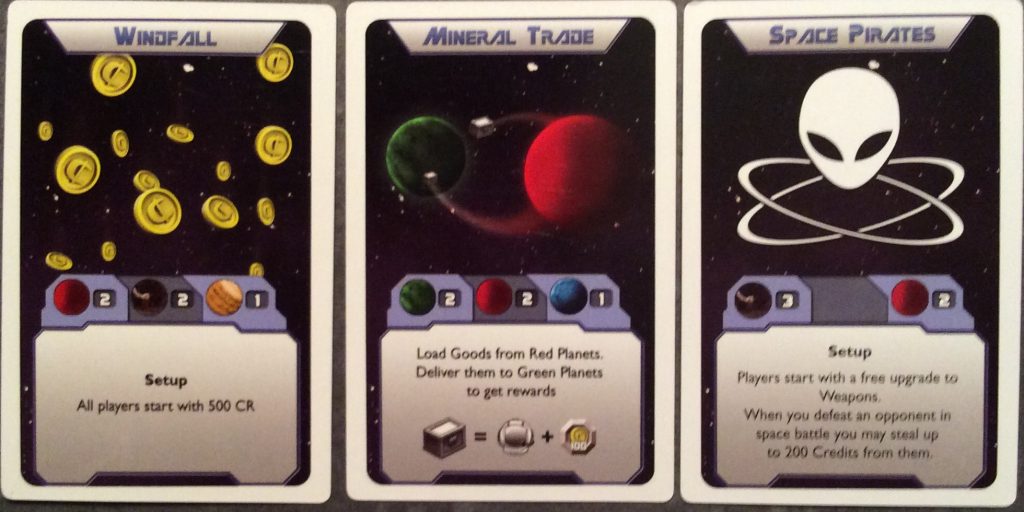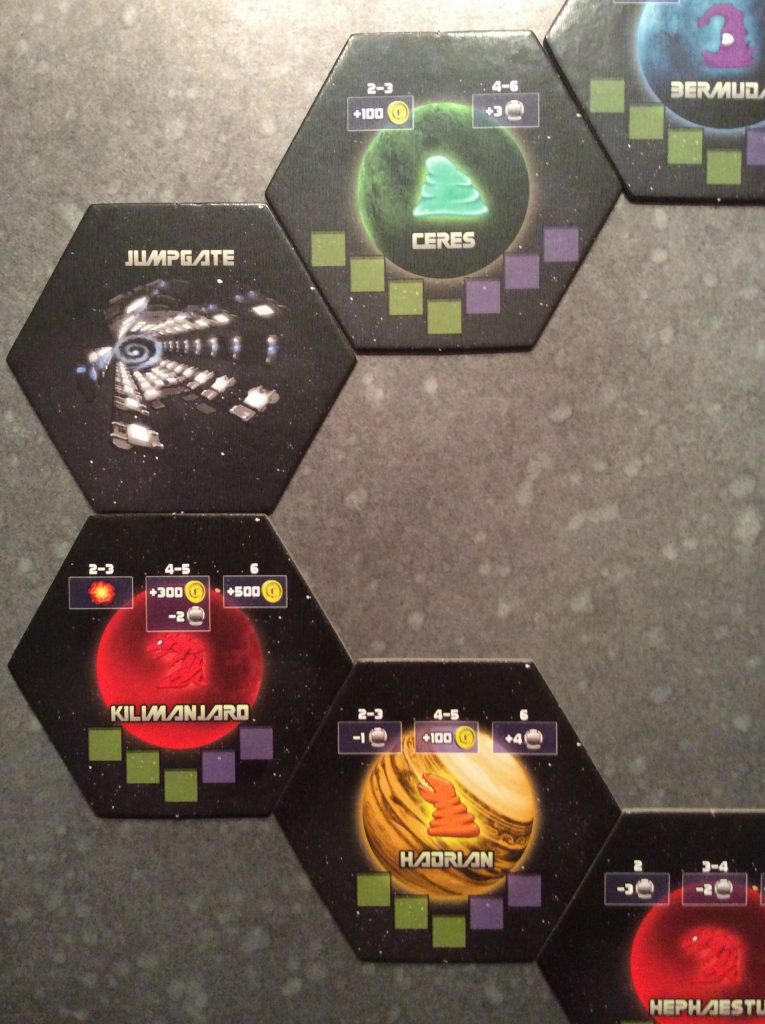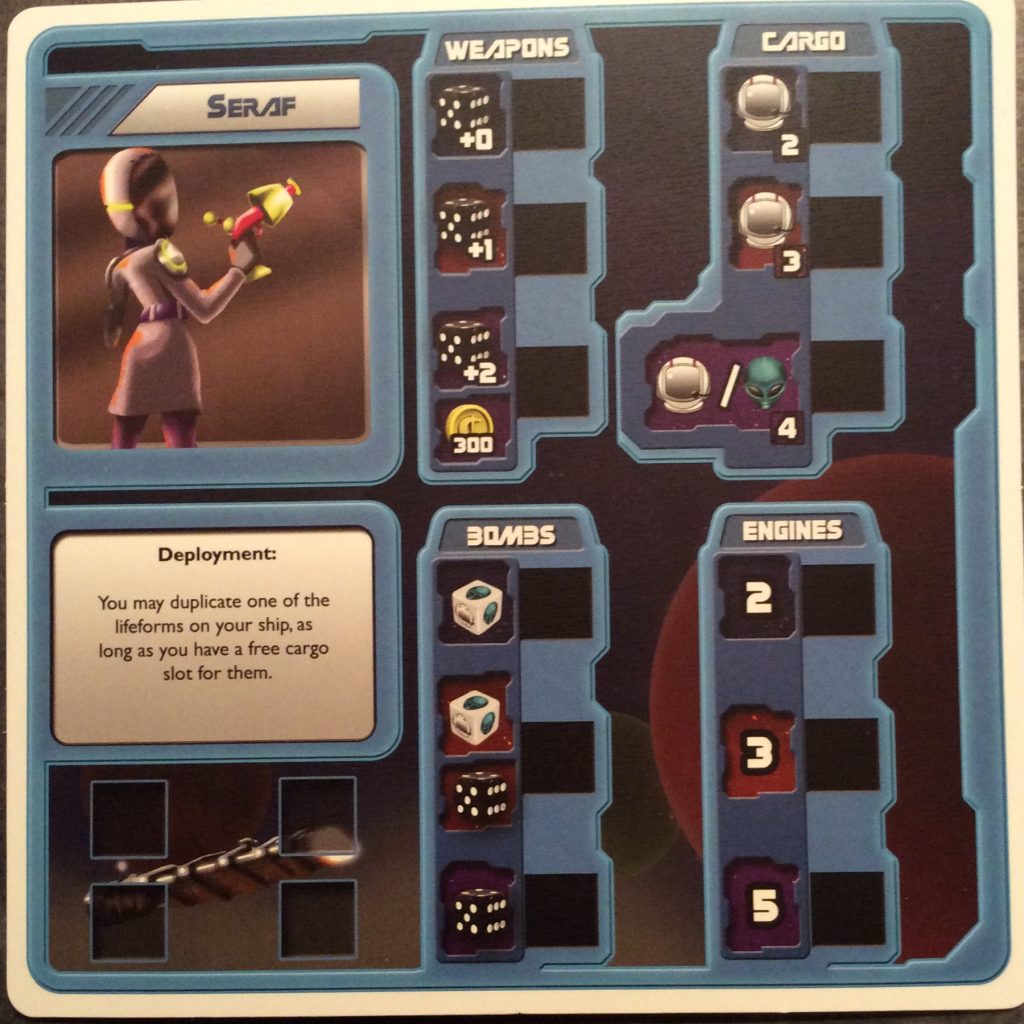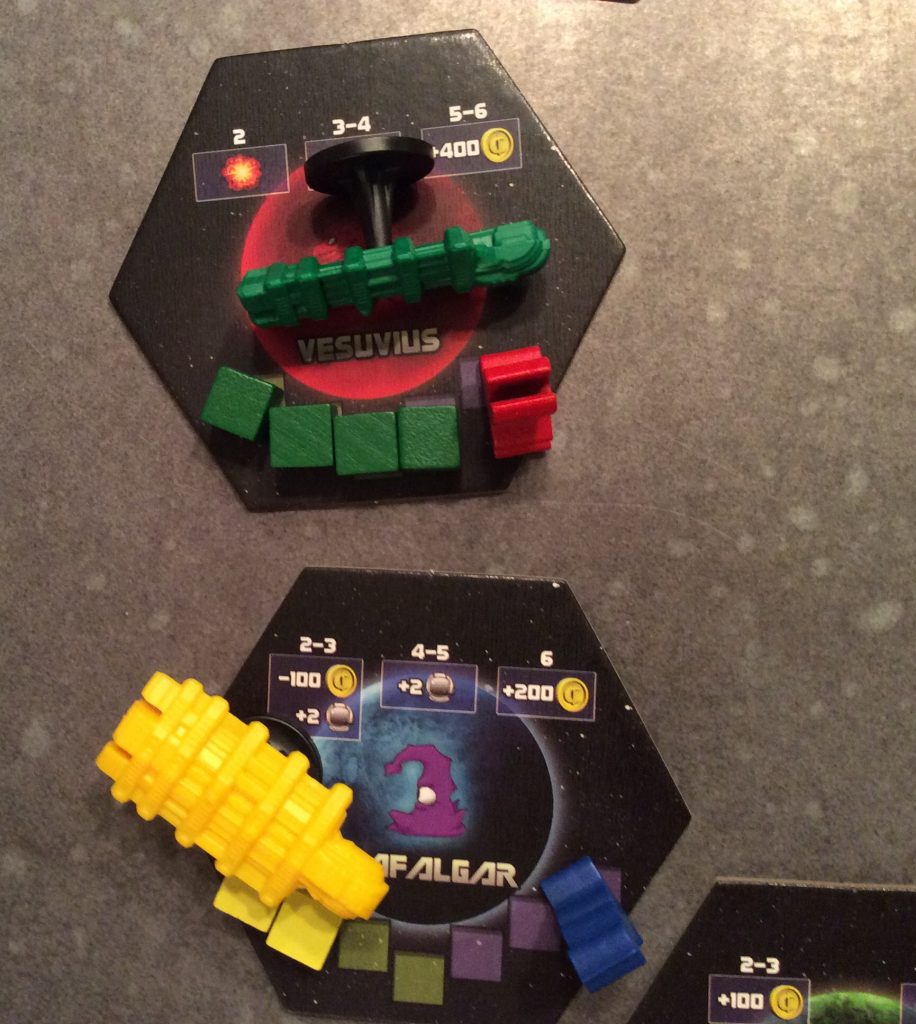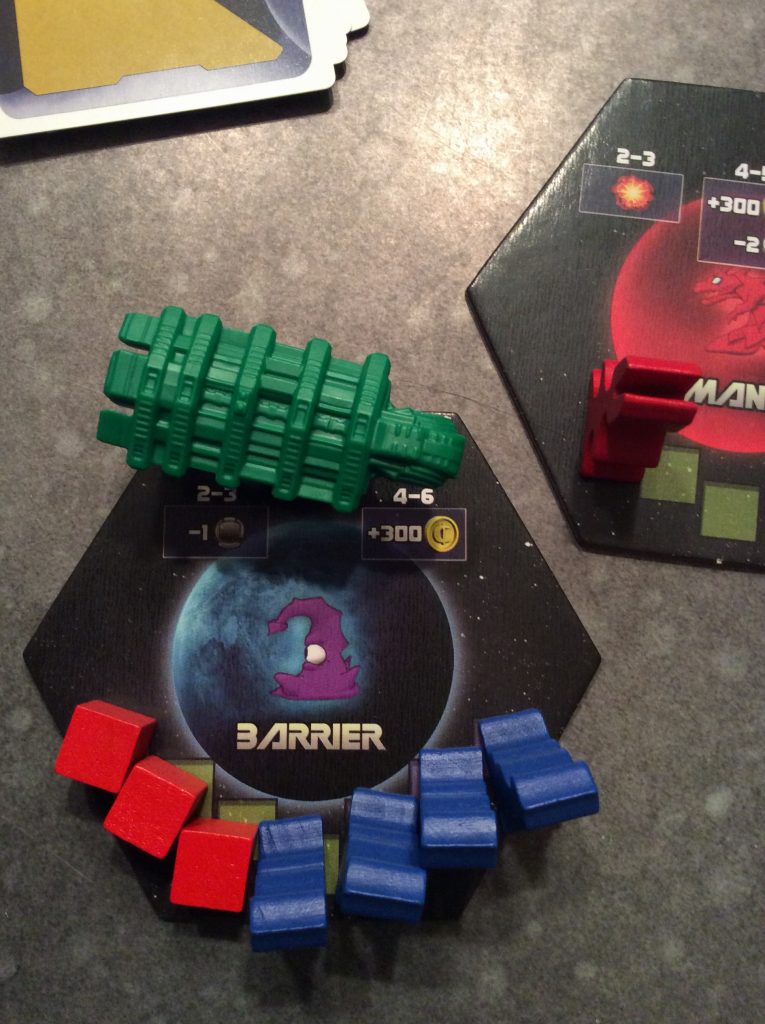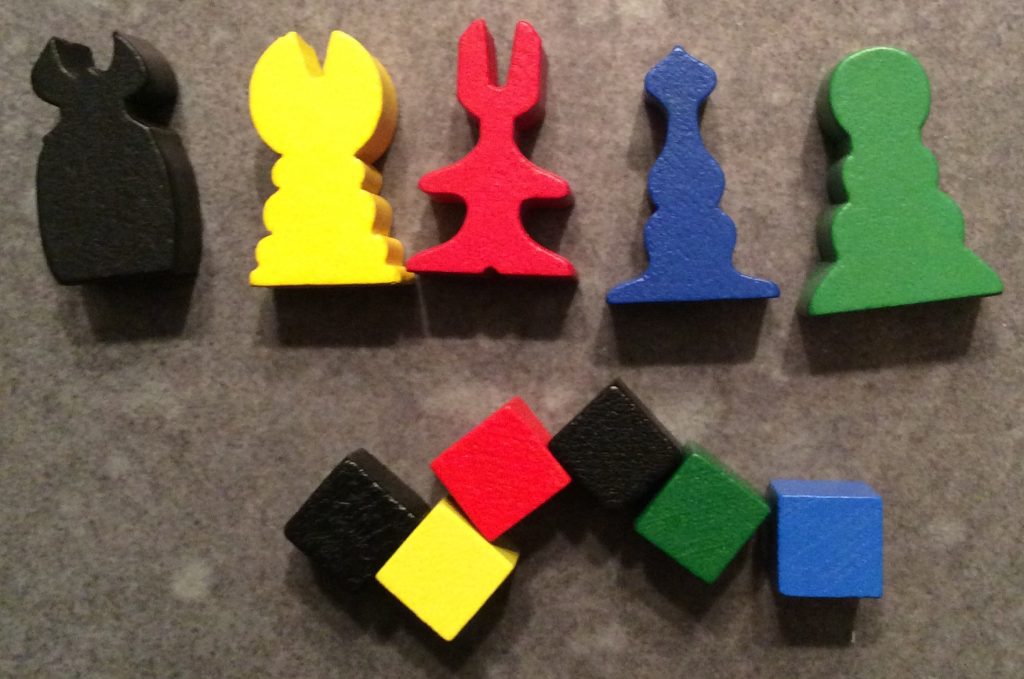First off, let me just say that the rulebook that comes with the game is boogers. Straight-up boogers. I read through it 3 times and was more confused each time I read it. So I figured I’d just sit down and play through it to learn it – nope. Okay, I’ll look for a video playthrough so that someone else could show me – nope. Maybe there’s something on the forums – an updated rulebook, you say? SUCCESS!
So…new rulebook in hand (or at least the PDF on my iPad) I set out to play Cosmic Pioneers!
Let’s start over. When I first got this game to review, I was really intrigued by the looks. The alien meeples are just fun and everything is such good quality. Plus I had just played Dwar7s Fall, so I was hopeful that this game would be fun. It was slightly disappointing to not be able to jump right in. In fact, it took me quite a while to find the rulebook so that I could (some of that time was me being discouraged by the initial setback). But now I have it, I have played several games and I’m here to tell you what I think. Right?
So…What kind of game is it anyway?
Cosmic Pioneers is, at its heart, an Area Control game. You and your opponents are trying to colonize new worlds, fight off aliens, deliver goods from one planet to another, or just blow each other out of the sky. There are other elements built in, but really it’s about controlling planets by having the most colonists present. Especially at the end of the game, since that’s pretty much the only way to score Victory Points. (You also get 1 VP for every 500 credits, but really, that is not that important).
There are also different scenarios that you choose from at the beginning of the gameplay, which changes the interaction between players and some of the game mechanics somewhat, but mostly they are about starting conditions or ways to gain more credits.
The basic game itself doesn’t change much, but thankfully there is still plenty of game here.
Okay…so…gameplay. (This area of this particular review will be more detailed because there is so much confusion over the way the game is actually played).
Basically, you have a ship that will travel to other planets and colonize, attack, or even crash land there.
The planets are laid out in a circular pattern with a Jumpgate at one end.
Your ship is represented by a card with stats that can be upgraded during the game. The ship’s stats are Engines (how far you can travel each turn), Cargo (how many Lifeforms/Goods you can carry and of what type), Bombs (used to blow up things on the planets’ surfaces), and Weapons (used to blow up other players’ ships).
At the beginning of the game, you get to upgrade one of these stats for free. We tried them all and I’ve got to say that Cargo and Engines seem like the way to go at the beginning. Bombs are useful later on, but I never really found much use for Weapons.
On your turn, you basically get to do 4 things. Movement/Combat, Adventure/Jumpgate, Deployment, and Bombardment. Before each round (except the first), the first player will draw an Alien card and follow the instructions, thus bringing the Aliens into the struggle for control, and each Alien acts completely different.
At the end of each round, the First Player Token moves to the next player on the left.
Movement is as simple as it seems. You can move up to as many spaces as you have in your Engines stats (either 2, 3, or 5). Each Planet tile is considered 1 space even if you can’t land there (Asteroid fields prevent landing). So on your turn, you move your ship or you can choose to stay put, not moving at all. If you move to a planet that does not have another ship on it, you move on to the next phase, Adventure/Jumpgate. If there is another ship present you MUST engage it in combat.
Combat is where your Weapons stat comes into play. Both players roll a D6 and then the higher roll wins (ties go to the Defending player). If you have upgraded your Weapons, you add either +1 or +2 to your roll and then compare. The winner stays on the planet in contention and the loser crash-lands.
Crash Landing means that you move your ship to any adjacent planet and offload all of your cargo immediately.
Crash Landing can be both good and bad, but we’ll talk about that more in a minute. If you Crash Land because you were the Attacker, your turn is now over, and you must wait until your next turn to right your ship and act again as normal. If you were the Defender, you will right your ship immediately at the beginning of your next turn.
Adventure/Jumpgate is different on every planet. During this phase the player rolls the D6 and, depending on the roll, performs the action prescribed. Each Planet has three different possibilities, but these can be one of five different actions: Add Colonists (from your supply, not your Cargo area), Remove Colonists (to their respective supplies), Get Credits, Lose Credit, and Crash Land. Any time you roll a 1 during the Adventure phase, you draw another Alien card and follow the instructions.
If you end your movement on the Jumpgate instead of a Planet, you always perform the same actions. Dispose of any unwanted Cargo (this could be Aliens, goods, whatever). Gain 200 credits plus 100 for each Planet you have control over. Upgrade one attribute at a cost of 500 credits per stat upgrade. Load as many colonists into your Cargo area as it will hold. The Jumpgate is a very important area, as it is both how you upgrade your ship to hold more Colonists and upgrade the Engines to go farther each turn.
After you have completed the Adventure phase, you move on to Deployment. During this phase you can place Colonists on the Planet you are on from your Cargo area, or remove Colonists/Aliens from the Planet and put them in your Cargo area. You can do this at the same time, so there is no need to worry about which must be done first.
The last phase is Bombardment and is optional. If you want to, you can Bomb the Planet you are on by rolling the white Bomb die. This will determine whether you kill Aliens on the Planet, or Colonists. If it’s Aliens, great. If it’s Colonists, it could mean your Colonists are the ones killed. You always kill the leftmost Alien and the rightmost Colonist, so if you’ve just placed a Colonist or two, it might not be wise to go Bombing them right away.
A few more notes:
Controlling a Planet: each planet has between 3 and 7 spots available for Colonization. These can be occupied by Colonists or Aliens. If the majority of spots are occupied by Colonists, the Planet is said to be Controlled. Whoever has the most Colonists present is in control of the Planet. If there is a tie, no one controls the Planet.
Crash Landing: if you Crash Land, you must empty out your Cargo area. If there are spots on the Planet for Colonists, you put them on the spots. If there are not, the Colonists die and go back to your supply. If you cannot fit all of your Colonists (or Aliens) from your Cargo area onto spots on the Planet, you get to choose which ones are placed and which ones die. As I said before, Crash Landing is not always a bad thing. A couple of times, it allowed a player to get one Planet closer to the Jumpgate while emptying his Cargo, a very positive outcome.
So that’s the basics – you play 12 rounds and the rest is just strategy. I know it sounds like a lot, but once you get the hang of it, the turns go pretty fast.
So…how does it play?
There is actually a lot going on with this game on every turn. You are constantly trying to figure out what your next move is going to be, and just when you think you have decided what to do, one of the other players will do something on their turn that totally screws you up. There is a lot of traveling back and forth to the Jumpgate to upgrade your ship and to pick up Colonists, and to be honest, I don’t know why anyone would venture very far from the Jumpgate until they have upgraded their Engines. We had one player who tried to travel all the way around the Planet circle without coming back to the Jumpgate often and ended up dead last with 7 Victory Points. Meanwhile, the players who came back every other turn or so ended up with 27 and 30.
Also, each Ship’s Captain has a special power that changes the way you play the game. If you wanted to, you could ignore this power the first time you play, but once you get the hang of everything, these powers change everything.
You also have the opportunity to pick up and move Aliens once you fully upgrade your Cargo stats. This can allow you to protect your Colonists while not risking bombing them out of existence, and because of this I didn’t find the bombs very helpful until the end of the game when I was trying to blow up my opponents because I had run out of positive things to do.
Each Planet’s Adventure interaction is different and sometimes you will be torn as to what Planet to actually visit, or whether it is better to go ahead and head back to the Jumpgate. Is it worth it for me to try to roll a 5 or 6 to add Colonists to the Planet from my supply, or should I just go grab some from the Jumpgate? Should I try to roll a 2 or 3 to remove someone else’s Colonist, or is there too much of a risk of Crash Landing?
There really are a bunch of interesting decisions to be made each turn, and you really have to pay attention to what other players are doing. If you space out on their turn, you may find yourself completely lost when it comes back around to you.
Final Thoughts?
Actually, it’s a lot more fun than I thought it would be. I’m not usually much for straight-up Area Control games, but this one is pretty fun. I loved the Alien Meeples, and the other components are all really good.
There are just enough decisions to be made each turn without it feeling too clunky and it moves along at a steady pace, as long as everyone is actually paying attention (if they don’t it can bog down a bit). At first, 12 turns doesn’t seem like it’s going to be enough time to get anything done, but once you start upgrading your ship, things get easier. Once you get the hang of the gameplay, there are multiple paths to victory, which is always a plus.
My main concern was the rulebook, but now that there is a new version out, the game can actually stand on its own. There’s actually a lot of game here, and it’s really pretty good.
Vesuvius Media provided us with a copy of the game in exchange for an honest review, which took way too long, but is exactly what we provided.
